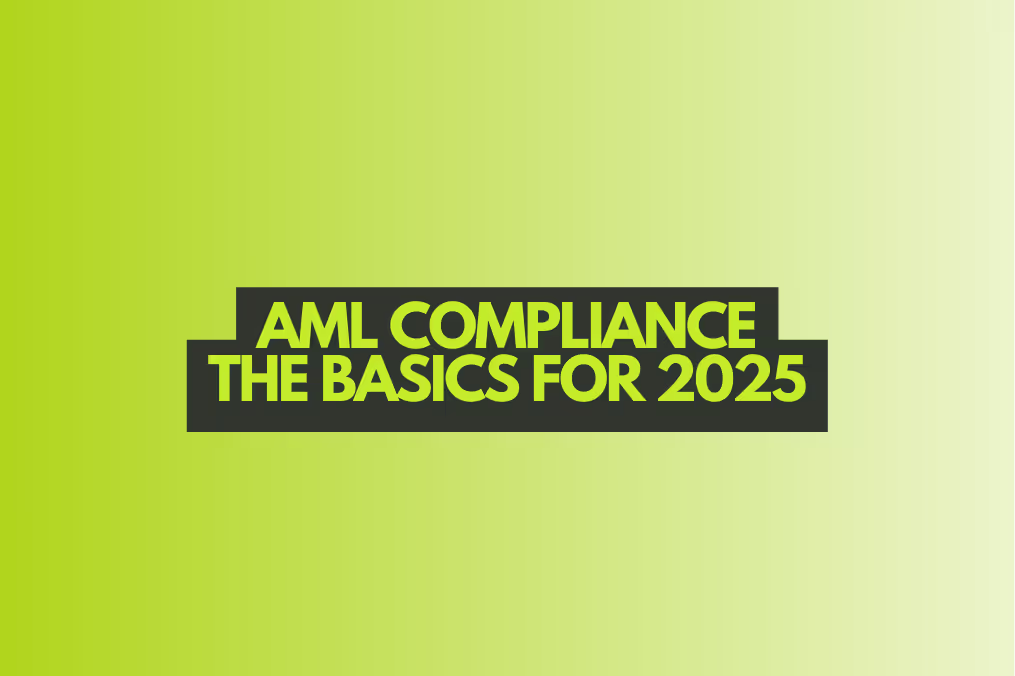
Anti-Money Laundering Compliance: The Basics for 2025
This comprehensive guide will review what the term anti-money laundering means, what the process looks like, and why AML is so important in banking, finance and also unregulated industries.
Understanding anti-money laundering (AML) compliance is essential for any regulated business in 2025. As financial crime becomes more sophisticated, so too do the legal and operational requirements for detecting and preventing it. This article explores the fundamentals of AML, how it works, and what organisations need to do to stay compliant in today’s regulatory environment.
What Does Anti-Money Laundering Mean?
Anti-Money Laundering (AML) refers to the laws, regulations, and procedures designed to prevent criminals from disguising illegally obtained funds as legitimate income. These measures also extend to the detection and prevention of terrorist financing, tax evasion, market manipulation, and the misuse of public funds.
AML frameworks became globally standardised following the creation of the Financial Action Task Force (FATF) in 1989. In 2001, its remit expanded to include counter-terrorist financing (CTF), marking a new era of international cooperation and regulatory development.
What Is Money Laundering?
Money laundering is the process of making illegally-gained proceeds appear legitimate. It typically involves three key stages:
- Placement – Injecting illegal funds into the financial system
- Layering – Obscuring the source through complex transactions
- Integration – Reintroducing the now-“cleaned” money into the economy
These processes undermine financial systems and fund further criminal activity. That’s why AML regulations are in place: to disrupt this cycle and ensure that both individuals and institutions are held accountable.
What Does the AML Compliance Process Involve?
AML compliance is built on three foundational activities:
1. Know Your Customer (KYC)
Before establishing a relationship with a client, businesses must verify the individual’s or entity’s identity and assess risk factors such as geography, occupation, and transaction history. This includes:
- Collecting identifying information (name, address, date of birth)
- Screening against sanctions and PEP (Politically Exposed Person) lists
- Establishing the source of funds and expected account behaviour
KYC also ensures sanctions compliance—screening individuals or organisations against international sanctions lists using solutions such as sanctions.io.
2. Customer Due Diligence (CDD)
CDD involves assessing the level of risk each client presents. For high-risk clients (e.g. those flagged as PEPs or operating in high-risk sectors or jurisdictions), Enhanced Due Diligence (EDD) is required. This may involve:
- Additional identity verification
- In-depth financial checks
- Closer monitoring of transaction behaviour
3. Ongoing Monitoring
Monitoring client behaviour doesn’t end after onboarding. Institutions must implement systems that flag:
- Unusual transaction patterns
- Geographic anomalies
- Activity that deviates from expected behaviour
This includes reporting obligations such as:
- Currency Transaction Reports (CTRs) for cash transactions exceeding legal thresholds
- Suspicious Activity Reports (SARs) for transactions lacking an apparent legal purpose
Why AML Compliance Matters in 2025
Financial Crime Is Expensive
Money laundering costs the global economy an estimated $800 billion to $2 trillion per year, according to the UN. Non-compliance with AML regulations has resulted in more than $32 billion in fines globally since 2009.
Reputational Risk Is High
Failure to comply can damage brand trust, trigger regulatory investigations, and lead to long-term reputational harm. In contrast, robust AML programs signal trustworthiness to clients, investors, and regulators.
Threats Are Evolving
Money laundering schemes are growing more sophisticated, often exploiting digital finance and cross-border loopholes. Modern AML solutions must be agile, data-driven, and tech-enabled to keep pace.
Compliance Supports Better Client Experiences
Effective AML compliance need not be a friction point. Smart integration of automated screening and streamlined onboarding ensures a secure yet user-friendly client journey.
How Do Companies Comply with AML Requirements?
To meet AML obligations, firms must implement a formal program aligned with the Five Pillars of AML Compliance:
- Internal Policies and Controls
A clear AML policy framework and standard operating procedures for customer screening, monitoring, and reporting. - Employee Training
Regular, documented training that ensures staff can identify red flags, process SARs and CTRs, and apply AML procedures correctly. - Appointed Compliance Officer (MLRO)
A senior individual responsible for overseeing the AML program, reporting to authorities, and keeping the business compliant. - Customer Due Diligence
Structured KYC and ongoing monitoring practices, often supported by automated systems for speed and accuracy. - Independent Audit and Testing
Regular third-party or internal reviews to test the effectiveness of the AML program and identify gaps or vulnerabilities.
Best Practice: The Risk-Based Approach
The risk-based approach is now a global best practice standard in AML compliance. Rather than applying the same level of scrutiny to all customers, businesses assess and categorise risk so they can allocate compliance resources accordingly.
This method considers factors such as:
- Jurisdictional risk (e.g. countries with weak AML laws)
- Industry risk (e.g. cash-intensive businesses)
- Customer behaviour (e.g. irregular transactions)
By proactively identifying higher-risk profiles, institutions can prevent criminal activity before it escalates—making the risk-based approach both effective and efficient.
Leveraging Technology for AML Compliance
Given the complexity and data requirements of modern AML frameworks, many firms now rely on technology-driven solutions such as:
- Real-time sanctions screening tools (e.g. sanctions.io)
- Transaction monitoring platforms using AI and machine learning
- Centralised data systems for audit readiness
Automated systems enable businesses to meet global standards at scale while reducing human error and compliance fatigue.
Final Thoughts
AML compliance is not just a legal obligation—it’s a fundamental component of business integrity in 2025. As regulations become more stringent and financial crimes more complex, organisations must be proactive, adaptable, and well-equipped.
A strong AML program protects your business from fines, reputational damage, and regulatory scrutiny—and ensures that you remain a trusted player in a fast-evolving financial landscape.
About sanctions.io
sanctions.io is a comprehensive Anti-Money Laundering solution with a simple to integrate API which companies can use to continuously scan their clients and business partners against the most important Sanctions & Crime Lists. Start your 7 Day FREE TRIAL right here.
To learn more about sanctions screening, sanctions.io's Ultimate Sanctions Screening Guide is an excellent resource to get started.



